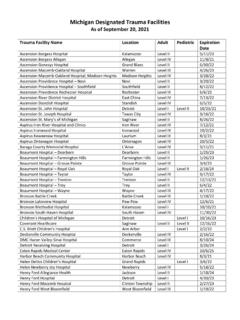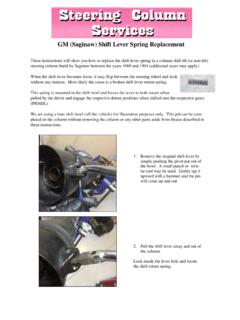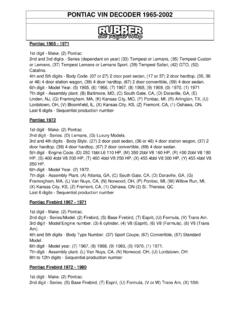Transcription of 2006-2011 Honda Civic A/C Diagnosis and Repair
1 EXPANSION VALVE (Meters the required amount of refrigerant into the evaporator)RECEIVER/DRYER DESICCANT (Traps debris, and removes moisture)A/C COMPRESSOR (Suction and compression)A/C CONDENSER (Radiation of heat)A/C PRESSURE SENSOR (Triple function) When the refrigerant is below 196 kPa ( kgf/cm2, 28 psi) or above 3,140 kPa (32 kgf/cm2,455 psi), the A/C pressure switch opens the circuit to the A/C switch and stops the air conditioning to protect the A/C compressor. When the refrigerant is above 1,470 kPa ( kgf/cm2, 213 psi), the A/C pressure sensor switches the radiator and A/C condenser fans to high FANEVAPORATOR (Absorption of heat)EVAPORATOR TEMPERATURE SENSORRELIEF VALVE (Relieves pressure at the A/C compressor when the pressure is too high)HIGH PRESSURE VAPORHIGH PRESSURE LIQUIDLOW PRESSURE LIQUIDLOW PRESSURE VAPORS ymptom Diagnostic procedureAlso check forRecirculation control doors do not change between Fresh and RecirculateRecirculation control motor circuit troubleshooting HVAC DTCs Blown fuse No.
2 36 (10 A) in the under-dash fuse/ relay box Cleanliness and tightness of all terminalsBlower, heater controls, and A/C do not work HVAC control power and ground circuit troubleshooting HVAC DTCs Blown fuse No. 36 (10 A) in the under-dash fuse/ relay box Poor ground at G504 Cleanliness and tightness of all terminalsBoth fans do not run at low speed with the A/C on (but the A/C compressor runs with the A/C on) Radiator and A/C condenser fan low speed circuit troubleshooting HVAC DTCs Blown fuse No. 7 (20 A) (All M/T models and A/T model of K20Z2 engine) or (30 A) (A/T models except K20Z2 engine) in the under-hood fuse/relay box, and No. 36 (10 A) in the under-dash fuse/relay box Poor ground at G301 Cleanliness and tightness of all terminalsThe A/C condenser fan does not run at high speed (but both fans run at low speed and the A/C compressor operates with the A/C on) A/C condenser fan high speed circuit troubleshooting HVAC DTCs Blown fuse No.
3 6 (20 A) and No. 15 ( A) in the under-hood fuse/relay box Poor ground at G301 Cleanliness and tightness of all terminalsBoth fans do not run at high speed with the A/C on (but both fans run at low speed and the A/C compressor operates with the A/C on) A/C pressure sensor troubleshooting: A/C pressure sensor circuit low voltage, except K20Z2 engine, K20Z2 engine A/C pressure sensor circuit high voltage,except K20Z2 engine, K20Z2 engineECT troubleshooting: ECT sensor 2 circuit low voltage, except K20Z2 engine, K20Z2 engine, ECT sensor 2 circuit high voltage, except K20Z2 engine, K20Z2 engine Powertrain DTCs, except K20Z2 engine, K20Z2 engine Cleanliness and tightness of all terminalsThe A/C compressor clutch does not engage (but both fans run with the A/C on)1.
4 A/C compressor clutch circuit troubleshooting2. A/C signal circuit troubleshooting HVAC DTCs Blown fuse No. 12 ( A) in the under-hood fuse/relay box, and No. 36 (10 A) in the under-dash fuse/relay box Check compressor thermal limiter Cleanliness and tightness of all terminalsA/C system does not come on (both fans and the A/C compressor do not work); heater is OK A/C pressure sensor troubleshooting: A/C pressure sensor circuit low voltage, except K20Z2 engine, K20Z2 engine A/C pressure sensor circuit high voltage, except K20Z2 engine, K20Z2 engine Powertrain DTCs, except K20Z2 engine K20Z2 engine Cleanliness and tightness of all terminals2006-2011 Honda Civic A/C Diagnosis and RepairAmbient tempHumidity %Inlet air tempStatic system pressure 45 psi minimumCenter vent temp~30 F < ambientLow side pressure Typical: ~ 30 psiHigh side pres-sureTypical: to X ambient FPressure behavior when AC is shut off:High Side Pressure PSILow Side Pressure PSIC enter Vent Air Temperature FInlet Air Temperature F1.
5 Connect a R-134a manifold to the high pressure and the low pressure service Record the relative humidity and ambient air Open the globe box. Remove the glove box stop on each side, then let the glove box hang Insert a thermometer in the dash center Place another thermometer (B) near the blower unit s recirculation inlet Test conditions: Avoid direct sunlight. Open hood. Open front doors. Set the fan switch to highest speed. Set the temperature control dial to the coldest set-ting. Press the Max A/C button. Run the engine at 1,500 rpm. No driver or passengers in Run the air conditioning for 10 minutes under the above test conditions.
6 Record the air temperature from the thermometer in the center vent. Record air intake temperature near the blower unit. Record the high and low system pressures from the A/C To complete the chart: Mark the center vent air temperature on the verti-cal scale. Mark the inlet air temperature (ambient air tem-perature) along the bottom line. If you are unable to measure the inlet air temperature use the ambient air temperature. Draw a line straight up from the inlet air tempera-ture to the top of the chart. Mark a point 10 % above and 10 % below the hu-midity level for each of the 3 zones. From each of the 6 points, draw horizontal lines left across the chart.
7 The center vent air temperature, low side pressure, and high side pressure should fall between the pairs of lines. Any measurements outside any of the pairs of lines indicate the need for further results Related symptoms Probable cause Remedy Discharge pressure abnormally high After stopping A/C compressor, pres-sure drops about 196 kPa ( kgf/cm2, 28 psi) quickly, and then falls gradually. Air in system Recover, evacuate, and recharge with specifi ed amount. No bubbles in sight glass when A/C condenser is cooled by water. Excessive refrigerant in system Discharge, evacuate, and recharge with specifi ed amount. Reduced or no airfl ow through A/C condenser. Clogged condenser or radiator fi nsA/C condenser or radiator fan not work-ing voltage and fan fan to A/C condenser is excessively hot.
8 Restricted fl ow of refrigerant in system Restricted lines. Discharge pressure abnormally low Excessive bubbles in sight glass;A/C condenser is not hot. Insuffi cient refrigerant in system Check for and low-pressures are balanced soon after stopping A/C compressor. Low side is higher than normal. Faulty A/C compressor discharge valveFaulty A/C compressor sealReplace the A/C compressor. Outlet of expansion valve is not frosted, low-pressure gauge indicates vacuum. Faulty expansion valveMoisture in , evacuate, and recharge with specifi ed pressure abnormally low Excessive bubbles in sight glass;A/C condenser is not hot. Insuffi cient refrigerant in system Repair the , evacuate, and recharge with specifi ed as valve is not frosted, and low-pressure line is not cold.
9 Low-pressure gauge indicates vacuum. Frozen expansion valve (Moisture in system)Faulty expansion valveRecover, evacuate, and recharge with specifi ed the expansion temperature is low, and the airfl ow from vents is restricted. Frozen evaporator Run the fan with A/C compressor off, then check evaporator temperature sensor. Expansion valve is frosted. Clogged expansion valve Clean or replace. Receiver/dryer outlet is cool, and inlet is warm (should be warm during opera-tion). Clogged receiver/dryer Replace. Suction pressure abnormally high Low-pressure hose and check joint are cooler than the temperature around evaporator. Expansion valve open too long Repair or replace. Check TEV temp sensorMake sure temp sensor contacts pressure is lowered when A/C condenser is cooled by water.
10 Excessive refrigerant in system Recover, evacuate, and recharge with specifi ed amount. High and low-pressures are equalized as soon as the A/C compressor is stopped, and both gauges fl uctuate while running. Faulty gasketFaulty high-pressure valveForeign particle stuck in high-pressure valveReplace the A/C compressor. Suction and discharge pressures abnormally high Reduced airfl ow through A/C con-denser. Clogged A/C condenser or radiator fi nsA/C condenser or radiator fan not work-ing voltage and fan fan bubbles in sight glass when A/C condenser is cooled by water. Excessive refrigerant in system Discharge, evacuate, and recharge with specifi ed amount. Suction pressures abnormally high and discharge pressure slightly highEvap freezes up?






